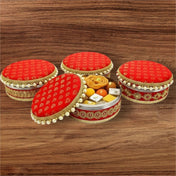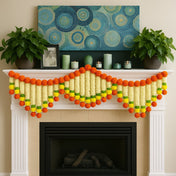Bringing a sacred Pooja space into your American home allows you to infuse your daily life with Indian spirituality. More than just a prayer area, it becomes a dedicated sanctuary for connecting with the divine, practicing meditation, and preserving cultural traditions.
In Indian households, this sacred space serves as the spiritual heart, where families:
- Perform daily prayers and rituals
- Celebrate religious festivals
- Seek peace and guidance during challenging times
- Pass down spiritual values to the next generation
Creating Your Pooja Space
Wondering how to set up a spiritual haven in your American home? You don’t need a separate room or an elaborate setup. With a thoughtful approach and the right elements, you can design a beautiful and functional Pooja space that seamlessly fits into your modern lifestyle.
Let LoveNspire guide you in creating a prayer space that honors your cultural roots while blending effortlessly with contemporary living. Discover how to transform any corner of your home into a serene, spiritual retreat filled with peace, devotion, and authenticity.
Incorporating Cultural Elements
To truly make your Pooja space feel sacred, consider incorporating elements that reflect your cultural heritage. For instance, using wooden printing stamps with intricate designs can add a personal touch to your decor. These hand-carved stamps are perfect for crafting and can be used in various creative projects around your home.
Celebrating Festivals
Your Pooja space will also serve as the focal point during religious festivals. To enhance the celebratory atmosphere, consider investing in some Happy Diwali photo booth props. These props are ideal for capturing memories during the festival of lights and can add an element of fun to your celebrations.
Creating a Comfortable Environment
Comfort is key when it comes to maintaining a peaceful Pooja space. Investing in high-quality bedding like 100% cotton fitted sheets can make your meditation or prayer time more comfortable. These breathable sheets will not only enhance comfort but also add an aesthetic appeal to your space.
Thoughtful Gifting Ideas
Lastly, remember that creating a Pooja space is not just about physical elements. It's also about the love and intention you put into it. Consider personalizing some items for the space or for gifting purposes using LoveNspire's personalized gifting ideas. This could include custom-made decor items or spiritual artifacts that resonate with you or your loved ones.
With these tips and resources from LoveNspire, you can create a beautiful, sacred Pooja space in your American home that honors both your cultural roots and contemporary lifestyle.
Understanding the Significance of a Pooja Space
A dedicated Pooja space serves as your personal sanctuary, bridging the gap between daily life and spiritual connection. This sacred corner transforms everyday moments into divine experiences, allowing you to pause, reflect, and reconnect with your inner self.
Significance in Daily Life
Your Pooja space becomes the center for:
- Morning prayers to start the day with positivity
- Evening aartis to express gratitude
- Meditation sessions for inner peace
- Festival celebrations with family and friends
Emotional and Spiritual Benefits
Having a dedicated worship space provides deep emotional and spiritual enrichment:
- Mental Clarity – Prayer and meditation help calm the mind
- Emotional Balance – A peaceful space aids in stress relief
- Spiritual Growth – Consistent practice deepens your divine connection
- Family Bonding – Shared worship experiences strengthen relationships
Cultural Significance
In an American home, your Pooja space serves as a cultural anchor, helping you:
- Pass down traditions to your children
- Introduce friends to Indian customs
- Spark meaningful conversations about spirituality
- Foster a sense of belonging in a multicultural society
Preserving Tradition in Modern Life
A well-designed Pooja space does more than preserve traditions—it creates a living connection between your cultural heritage and contemporary life. This sacred space acts as your spiritual compass, grounding you in faith while guiding you through life’s journey.
To enhance this sacred space, consider incorporating traditional elements such as a banana leaf backdrop which can serve as an exquisite backdrop for your Pooja.

Moreover, adorning yourself with antique gold plated South Indian bracelet bangles during religious ceremonies can add a touch of authenticity to the experience.
Similarly, wearing silver toe rings or CZ nose rings can also enhance your traditional attire during these occasions.
Finally, consider using eco-friendly items like Ganesha print jute bags for distributing return gifts during festivals or poojas. These not only serve a practical purpose but also reflect the essence of Indian culture.
Choosing the Right Location for Your Pooja Space
Selecting the right spot for your sacred space is essential for fostering a peaceful and spiritual atmosphere. Ancient Vastu Shastra principles provide guidance on choosing the most auspicious direction for your Pooja area.
The Northeast Corner - Isanya
In Vastu Shastra, the northeast corner of a home, known as "Isanya," is considered the most sacred for worship. This placement:
- Attracts positive energies that uplift the space
- Enhances mental clarity and focus during prayer
- Encourages a natural flow of spiritual vibrations
Alternative Locations
If the northeast corner isn’t available, you can also consider:
- East-facing space – Symbolizes new beginnings and enlightenment
- North-facing area – Associated with prosperity and positivity
- Center of the home – Represents balance and harmony
Creating a Serene Environment
For an ideal worship space, ensure your chosen location is:
- Away from bathrooms to maintain sanctity
- Distant from kitchen noise and odors
- Free from heavy foot traffic for uninterrupted prayer
- Well-ventilated with ample natural light and airflow
By carefully selecting the right location, you create a harmonious and spiritually energized space that enhances your daily devotion and meditation practices.
To enhance the ambiance of your Pooja space, consider incorporating decorative elements such as a hammered copper plating dryfruits jar with lid for offering or storing prasadam.
Space Requirements
A dedicated area of:
- Minimum 2x2 feet for a small altar
- 4x4 feet for a more elaborate setup
- Sufficient height for standing prayers
Remember to keep your sacred space elevated from the floor, preferably at waist height. This elevation helps maintain the sanctity of your worship area and creates a distinct boundary between everyday living spaces and your spiritual sanctuary.
You might also want to personalize your Pooja experience with items like personalized candle holders or a Durga Mata backdrop for special occasions such as Navratri. Additionally, incorporating traditional elements like a Peacock Deepam brass finish diya can further enrich your spiritual ambiance.
Setting Up Your Altar or Puja Table
Designing a thoughtful altar setup is at the core of your sacred space. Here are the key elements that make up a traditional puja table:
Core Sacred Items
- Deities: Place your primary deity at the center, slightly elevated
- Photos of spiritual teachers or gurus
- Sacred texts like the Bhagavad Gita or your preferred religious scripture
- Bell (Ghanta): Used to mark the beginning and end of prayers
Offering Elements
- Diya or oil lamp representing divine light
- Incense holder for aromatic worship
- Small bowls for kumkum, vibhuti, and other sacred powders
- Water vessel (kalasha) symbolizing life and purity
- Fresh flowers in a small vase
- Plate for prasad offerings
Arrangement Tips
- Place larger items toward the back to create depth.
- Keep frequently used essentials within easy reach.
- Use small risers or boxes to create levels and enhance visibility.
- Leave ample space in front for sitting and performing rituals comfortably.
- Maintain symmetry for a balanced and harmonious setup.
A well-organized puja table invites divine energy and ensures a smooth flow during daily prayers. Adding a small drawer or storage space beneath the altar helps keep extra supplies neatly arranged and easily accessible.
Your altar setup can be as minimal or elaborate as you wish - what matters most is the devotion and intention you bring to this sacred space. You might also want to incorporate seasonal decorations such as a Happy Navratri cutout sign, which can add an extra layer of festivity during special occasions like Navratri.
Decorating Your Pooja Space with Cultural Elements
Transform your sacred space into a vibrant celebration of Indian culture with thoughtful decorative elements.
Fresh Flowers
Fresh flowers infuse your pooja space with vitality and divine energy. Consider crafting small garlands (malas) using artificial marigolds, roses, or jasmine to adorn your deities. A decorative brass or silver vase can hold fresh blooms, replenished daily as a sacred offering. If you prefer a long-lasting option, you might want to explore these artificial marigold flowers which are perfect for such decorations.
Traditional Textiles
Infuse warmth and authenticity into your pooja space with traditional textiles. Consider incorporating the following elements:
- Silk or cotton chunnis (scarves) in vibrant hues
- Embroidered cushions adorned with religious motifs
- Handwoven runners featuring traditional patterns
- Brocade fabrics embellished with golden thread work
Artistic Wall Décor
Your pooja space’s walls offer an ideal canvas for artistic expression. Elevate the ambiance with these decorative touches:
- Hand-painted Madhubani art showcasing religious scenes
- Intricate toran (decorative door hangings)
- Framed kalash patterns
- Traditional brass bells (ghanta)
Temporary Floor Decorations
Enhance the sacred atmosphere with temporary floor decorations crafted using various artistic techniques:
- Rangoli patterns created with colored powders
- Alpana designs drawn with rice paste
- Flower petals arranged in geometric patterns
Sacred Accents
Incorporate these meaningful decorative accents, which hold special significance in Hindu rituals:
- Brass or copper kalash (sacred vessels)
- Traditional oil lamps (diyas)
- Ornate puja thali (offering plate)
- Intricately carved wooden or marble chowki (small table)
Spiritual Ambiance
To enhance the spiritual ambiance, consider incorporating some gold plated idols of deities like Laxmi, Ganesha, and Radha Krishna into your decor. These cultural elements not only beautify your space but also create an authentic atmosphere that deepens your spiritual connection during prayer and meditation.
Unique Backdrops
If you're looking for unique backdrops for your pooja space, options like the elephant Ganesh backdrop or the Radha Krishna with peacock backdrop could serve as stunning visual focal points.
Moments of Tranquility
Finally, for moments of meditation and tranquility within this sacred space, consider using an Indian Tibetan decorative round shape meditation singing bowl set, known for their sound therapy benefits and ability to promote positive energy.
Maintaining Cleanliness and Purity in Your Sacred Space
A well-maintained Pooja space reflects your dedication to spiritual practice. Cleanliness is more than just physical tidiness—it fosters spiritual clarity and devotion.
Daily Cleaning Ritual Checklist
- Gently dust the altar and surrounding areas with a clean, soft cloth.
- Remove wilted flowers and replace them with fresh blooms.
- Polish brass items using an appropriate cleaner.
- Wipe the floor with a mixture of water and natural cleansers.
- Empty and cleanse the offering vessels.
Pro Tip: Keep a separate set of cleaning supplies exclusively for your Pooja space.
Sacred Space Guidelines
- Always remove shoes before entering.
- Wash hands before handling any sacred items.
- Keep food offerings covered to maintain purity.
- Store incense and matches in airtight containers.
- Clean any spills immediately to preserve cleanliness.
A spotless Pooja space radiates positive energy and deepens your spiritual connection. Treat the cleaning process as a mindful ritual—an act of devotion that upholds the sanctity of your sacred space.
Additionally, if you're preparing for festivals like Navratri, consider incorporating some vibrant elements into your Pooja space. For instance, during Navratri, you can create a captivating display known as Golu, which is a vibrant tradition that adds to the festive spirit.
Lighting: An Essential Element in Your Pooja Space
Lighting plays a vital role in transforming your pooja space into a divine sanctuary. Traditional diyas (oil lamps) emit a warm, flickering glow that connects you to ancient spiritual traditions. Here’s how to use lighting effectively in your sacred space:
1. Embrace Diyas for Warmth and Tradition
Position these sacred lamps thoughtfully:
- Place brass or clay diyas at the center of your altar.
- Arrange tea lights around your deities to enhance the spiritual ambiance.
- Install soft, ambient lighting fixtures above the space for a soothing effect.
The glow of diyas carries deep spiritual meaning:
"Light symbolizes divine energy, dispelling darkness and ignorance from our minds and hearts."
2. Explore Various Lighting Options
Enhance your pooja space with different lighting choices:
- Natural Light: Position your altar to capture the soft glow of morning sunlight.
- Electric Diyas: A safe and convenient alternative for daily use.
- Himalayan Salt Lamps: Emit a calming amber glow, promoting tranquility.
- LED String Lights: Add a gentle sparkle, especially during festivals.
Ensure proper ventilation when using traditional oil lamps. The interplay of light and shadow in your sacred space fosters a serene atmosphere, enhancing meditation and spiritual connection.
Personal Touches to Enrich Your Sacred Space
Your Pooja space can become a deeply personal sanctuary by incorporating meaningful items that tell your family's spiritual story. Consider adding:
- Family Heirlooms: Place your grandmother's brass diya or your great-aunt's sacred bells in your space. These treasured items carry generations of prayers and blessings.
- Sacred Gifts: Display spiritual items gifted by loved ones or brought from significant temple visits.
- Meaningful Photographs: Create a small photo corner with pictures of:
- Your family's spiritual guru
- Temples you've visited
- Religious ceremonies that hold special meaning
4. Handcrafted Elements: Add items you've created yourself:
- Hand-painted diyas
- Self-made torans
- Personally designed rangoli patterns, like a personalized acrylic rangoli with tea light candles
Adding personal touches transforms your pooja space from a traditional prayer area into a deeply personal reflection of your spiritual journey. Each element carries significance, enriching your daily prayers with meaning and a profound sense of connection.
Remember to position these personal items respectfully, ensuring they complement rather than overshadow your deities and main altar pieces. You might also want to consider incorporating some decorative elements, such as the antique dancing lady door pull handles, which could add a unique charm to your sacred space.
Embracing Cultural Significance Through Rituals in Your Pooja Space
Your pooja space becomes truly vibrant through the sacred rituals you perform throughout the year. Each ritual holds deep cultural significance, connecting you to centuries-old traditions, even while residing in your American home.
Key Annual Rituals to Observe
- Diwali – Illuminate your pooja space with diyas, create colorful rangoli, and offer special prayers during this festival of lights.
- Ganesh Chaturthi – Dedicate a space for Lord Ganesha’s idol, accompanied by modak offerings and devotional prayers.
- Navratri – Honor the nine forms of Goddess Durga by setting up an altar with specific offerings for each day.
- Janmashtami – Adorn your altar with fresh flowers and prepare special bhog in devotion to Lord Krishna.
Daily Rituals for Spiritual Connection
- Begin the day with morning aarti, offering fresh flowers and incense.
- Offer water to the Sun God as a gesture of gratitude.
- Light a deepam (oil lamp) in the evening to create a serene ambiance.
- Recite mantras or prayers to enhance spiritual focus.
Your pooja space can be adapted to accommodate these rituals, evolving to meet the spiritual needs of different occasions and personal practices.
Keep a dedicated drawer or shelf for festival-specific items, such as Indian bracelet boxes that can hold your jewelry used during rituals, and maintain a collection of traditional ritual items like:
- Brass or silver pooja thali
- Kumkum and rice containers
- Bell (ghanti)
- Incense holder
- Small kalash (sacred water vessel)
Remember to consult your family elders or local temple priests for guidance on performing these rituals correctly. Each practice strengthens your connection to your cultural heritage while creating a meaningful spiritual routine in your American home.
Conclusion
Creating a sacred pooja space in your American home is a meaningful way to honor cultural heritage while embracing modern living. A dedicated prayer area serves as a spiritual anchor, fostering peace and divine energy in daily life.
Choosing a peaceful corner that resonates with positive energy helps establish a serene atmosphere. Blending traditional elements with contemporary aesthetics allows the space to feel both authentic and harmonious with your home. Adding personal and meaningful items enhances the connection to your spiritual journey, making the space uniquely yours.
The beauty of a pooja space lies in its adaptability, allowing traditional practices to be incorporated into modern lifestyles while preserving their sacred essence. As life evolves, the space can grow with it, reflecting both cultural roots and present experiences.
At LoveNspire, we celebrate this fusion of tradition and modernity. A pooja space is more than a place of worship—it is a testament to cultural connections that transcend borders, bridging Indian heritage with life in America.






















